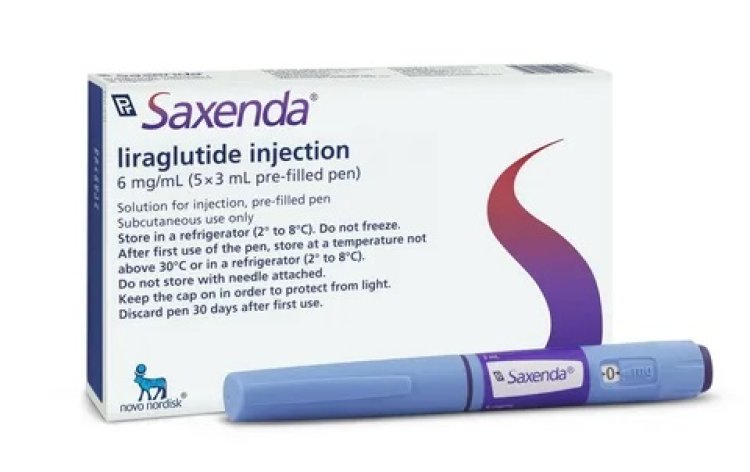Saxenda Injection: Doctor’s Advice for Beginners
Share this Post to earn Money ( Upto ₹100 per 1000 Views )
Starting your weight loss journey with Saxenda Injection can feel exciting—but also a little overwhelming. Like any new treatment, understanding what to expect and how to manage it is key to your success. To make your transition smoother, this guide compiles the top advice doctors often share with first-time Saxenda users.
Whether you're preparing to begin Saxenda or have just taken your first dose, this blog offers trusted medical insights to help you use the medication safely, effectively, and confidently.
What Is Saxenda Injection and How Does It Work?
Saxenda Injection حقن سيكسيندا is an FDA-approved prescription medicine that supports long-term weight loss in individuals who are overweight or obese. It contains liraglutide, which mimics a natural hormone (GLP-1) that:
-
Reduces appetite
-
Increases feelings of fullness
-
Slows stomach emptying
-
Helps control blood sugar levels
Doctors recommend Saxenda alongside a balanced diet and regular exercise—not as a replacement for them. This combination is essential for consistent and lasting results.
Doctor’s Tip #1: Understand If You’re an Ideal Candidate
Before starting Saxenda, your doctor will evaluate if the medication is right for you. Saxenda is typically recommended if:
-
Your BMI is 30 or higher (classified as obese), or
-
Your BMI is 27 or higher with a weight-related condition such as:
-
High blood pressure
-
High cholesterol
-
Type 2 diabetes
-
Sleep apnea
-
It’s not meant for everyone. Individuals with a history of medullary thyroid cancer, pancreatitis, or Multiple Endocrine Neoplasia syndrome type 2 (MEN 2) should not take Saxenda.
Doctor’s Tip #2: Start Low and Go Slow
Saxenda is introduced gradually. Doctors stress the importance of following the dose escalation schedule to reduce side effects such as nausea or vomiting. Here's a typical schedule:
-
Week 1: 0.6 mg
-
Week 2: 1.2 mg
-
Week 3: 1.8 mg
-
Week 4: 2.4 mg
-
Week 5 and onward: 3.0 mg (maintenance dose)
This slow increase gives your body time to adapt to the medication.
Doctor’s Tip #3: Take It at the Same Time Daily
Consistency matters. Saxenda should be taken once a day, at any time, with or without food. However, doctors recommend choosing a specific time—like before breakfast or before bed—and sticking with it.
Also, rotate your injection site daily (abdomen, upper arm, or thigh) to avoid skin irritation.
Doctor’s Tip #4: Track Your Progress
From day one, your doctor may advise you to keep a log of:
-
Weight changes
-
Daily doses
-
Side effects (if any)
-
Mood and energy levels
-
Dietary intake and exercise habits
This information helps your provider fine-tune your plan and makes it easier to notice trends and improvements over time.
Doctor’s Tip #5: Watch for Early Side Effects—And Don’t Panic
Doctors often reassure new users that some side effects are normal during the first few weeks. These may include:
-
Nausea
-
Constipation or diarrhea
-
Headaches
-
Fatigue
-
Injection site irritation
Most of these effects fade as your body adjusts. If side effects persist beyond a few weeks or feel severe, reach out to your provider right away.
Doctor’s Tip #6: Don’t Skip Meals
While Saxenda reduces appetite, skipping meals is not recommended. Doing so may lead to:
-
Low energy levels
-
Nutrient deficiencies
-
Nausea or dizziness
Instead, eat small, balanced meals that include protein, healthy fats, and complex carbohydrates. Drinking plenty of water also supports digestion and helps minimize side effects.
Doctor’s Tip #7: Combine Saxenda with Healthy Habits
Saxenda works best when paired with:
-
A calorie-controlled diet tailored to your goals
-
Regular exercise (at least 150 minutes of moderate activity per week)
-
Sleep hygiene and stress management techniques
Saxenda isn’t a quick fix. Doctors emphasize it as a tool, not a substitute, for making lifestyle changes.
Doctor’s Tip #8: Be Patient—And Don’t Obsess Over the Scale
Weight loss is a gradual process. Doctors often set realistic expectations, such as:
-
1–2 pounds of weight loss per week
-
A total of 5–10% of your starting weight over several months
If you haven’t lost at least 4% of your initial body weight by week 16, your doctor may reassess your plan or consider discontinuing Saxenda.
Remember: Inches lost, better sleep, more energy, and improved labs are just as important as the number on the scale.
Doctor’s Tip #9: Avoid Alcohol and Overeating Triggers
While moderate alcohol is not forbidden, doctors suggest avoiding it—especially during the early stages. Alcohol can:
-
Increase your risk of nausea
-
Lower your willpower to make healthy food choices
-
Add unnecessary calories
Also, stay mindful of emotional or binge eating triggers. Use Saxenda’s appetite suppression as an opportunity to develop mindful eating habits.
Doctor’s Tip #10: Know When to Contact Your Provider
While most side effects are manageable, call your doctor immediately if you notice:
-
Persistent or severe abdominal pain
-
Yellowing of the skin (possible liver or gallbladder issue)
-
Difficulty breathing
-
Swelling in the neck or signs of a thyroid issue
-
Mood changes, such as depression or anxiety
Doctors prefer early intervention rather than waiting for issues to escalate.
Doctor’s Final Advice: Stay Supported
The journey to weight loss isn’t just physical—it’s also emotional and mental. That’s why doctors recommend:
-
Regular follow-ups every few weeks or months
-
Connecting with a nutritionist or dietitian
-
Joining a support group or therapy program
-
Celebrating small victories
Having a strong support system can boost your motivation, reduce stress, and make it easier to stick with Saxenda long-term.
Conclusion: Trust the Process and Work with Your Doctor
Saxenda Injection has proven to be a valuable weight loss aid when used correctly under medical supervision. By following your doctor’s advice, starting slowly, watching for side effects, and combining Saxenda with positive lifestyle habits, you set yourself up for success.

















